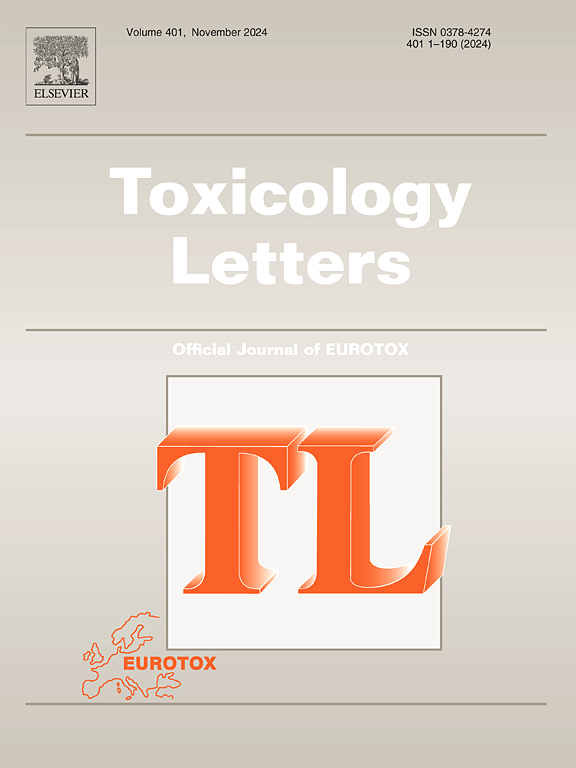captagon和阿奇霉素通过氧化应激、细胞凋亡和上调PI3K/AKT/NF-kB通路对大鼠心脏的协同毒性作用
IF 2.9
3区 医学
Q2 TOXICOLOGY
引用次数: 0
摘要
苯乙胺(Captagon)是一种苯丙胺和茶碱的混合物,具有兴奋剂的作用,而阿奇霉素(AZ)是一种常用的大环内酯类抗生素。非法药物和治疗药物的共同使用可导致严重的健康风险,特别是心脏毒性。本研究旨在评估Captagon (Capta)和阿奇霉素/Captagon相互作用对成年雄性大鼠的心脏毒性作用。42只动物随机分为6组:ⅰ组(对照)和ⅱ组(AZ(30 mg/kg/d)),从试验第14天开始,持续2周。III组(Capta10 mg/kg/天)、IV组(Capta20 mg/kg/天)、V组(AZ+Capta10)、VI组(AZ+Capta20)每日28天。评估心电图(ECG)、心肌酶、氧化应激标志物、炎症基因表达、组织病理学和免疫组织化学变化。阿斯利康和卡普他单独或联合用药可引起心脏毒性。LDH和CTNI水平升高,心电图改变为HR升高,QT间期延长,ST段升高并伴有心脏组织病理学改变。抗氧化剂SOD、GSH、TAC和过氧化氢酶显著降低,同时氧化应激MDA和NO显著升高。Capta20和AZ+Capta组ERK、TNF-α、NF-ҡB、PI3K/AKT、Il-1β和IL-6均呈剂量依赖性升高。AZ和Capta20共给药可产生caspase-3和BAX的强烈免疫表达,并对Bcl-2产生大面积的阴性反应。AZ和Capta共给药通过氧化应激、炎症和凋亡途径诱导心脏毒性。教育医疗保健提供者和患者关于潜在的有害相互作用是很重要的。本文章由计算机程序翻译,如有差异,请以英文原文为准。
Synergistic cardiotoxic effects of captagon and azithromycin in rat via oxidative stress, apoptosis and upregulation of the PI3K/AKT/NF-kB pathway
Fenethylline (Captagon) is a blend of amphetamine and theophylline that functions as a stimulant, while azithromycin (AZ) is a commonly prescribed macrolide antibiotic. The co-usage of illicit substances and therapeutic drugs can result in substantial health risk especially cardiotoxicity. This study aimed to assess cardiotoxicity effects of Captagon (Capta) and Azithromycin/Captagon interaction in adult male rats. Forty-two animals were assigned into 6 groups: Group I (Control) and group II (AZ (30 mg/kg/day) starting from the 14th day of the experiment and for 2 weeks. Group III (Capta10 mg/kg/day), group IV (Capta20 mg/kg/day), group V (AZ+Capta10) and group VI (AZ+Capta20) daily 28 days. Electrocardiogram (ECG), cardiac enzymes, oxidative stress markers, inflammatory genes expression, histopathological and immunohistochemical changes were assessed. Administration of AZ and Capta alone or in combination cause cardiotoxicity. This was indicated by elevated LDH and CTNI levels, ECG changes as increased HR, prolonged QT interval and elevated ST segment accompanied by cardiac histopathological changes. There was a significant reduction in antioxidants SOD, GSH, TAC, and catalase, alongside a significant rise in oxidative stress MDA and NO. Significant rise of ERK, TNF-α, NF-ҡB, PI3K/AKT, Il-1β and IL-6, in both the Capta20 and AZ+Capta groups in dose dependent manner. The Coadministration of AZ and Capta20 produced intense immunoexpression of caspase-3 and BAX and wide areas of negative reactivity for Bcl-2. Coadministration of AZ and Capta induced cardiotoxicity through oxidative stress, inflammation, and apoptosis pathways. It is important to educate healthcare providers and patients about the potential harmful interactions.
求助全文
通过发布文献求助,成功后即可免费获取论文全文。
去求助
来源期刊

Toxicology letters
医学-毒理学
CiteScore
7.10
自引率
2.90%
发文量
897
审稿时长
33 days
期刊介绍:
An international journal for the rapid publication of novel reports on a range of aspects of toxicology, especially mechanisms of toxicity.
 求助内容:
求助内容: 应助结果提醒方式:
应助结果提醒方式:


